For so many of us today on the planet, we have never really had to think too much about food beyond its placement in a supermarket. But the most common foods that we eat are bread-based products, and with these products, it all starts with flour. Flour is an essential base item that begins virtually any bread dish, the process involved in making flour is a major industry. With this in mind, how is flour made?
The grain most commonly ground into flour is wheat. Flour mills typically use high protein or hard wheat species to make bread flour, and lower protein or soft wheat species to make cake and pastry flour. A compromise between the two types is also blended and ground to make all purpose flour.
Have you ever wondered exactly where the materials come from to create breads, cakes, and other fortified carbohydrates? Have you ever wondered exactly what flour is and the process it takes to create raw materials into the powdery substance? If so, this article is certainly for you. In this guide, we will look at exactly what flour is, as well as all its varied derivatives. Read on to find out everything there is to know about flour.
How Is Flour Made: Step By Step
Flour is a finely ground powder prepared from grain or other starchy plant foods and used in baking. Although flour can be made from a wide variety of plants, the vast majority is made from wheat. Dough made from wheat flour is particularly well suited to baking bread because it contains a large amount of gluten, a substance composed of strong, elastic proteins.
The gluten forms a network throughout the dough, trapping the gasses which are formed by yeast, baking powder, or other leavening agents. This causes the dough to rise, resulting in light, soft bread.
Flour has been made since prehistoric times. The earliest methods used for producing flour all involved grinding grain between stones. These methods included the mortar and pestle (a stone club striking grain held in a stone bowl), the saddlestone (a cylindrical stone rolling against grain held in a stone bowl), and the quern (a horizontal, disk-shaped stone spinning on top of grain held on another horizontal stone). These devices were all operated by hand.
The millstone, a later development, consisted of one vertical, disk-shaped stone rolling on grain sitting on a horizontal, disk-shaped stone. Millstones were first operated by human or animal power. The ancient Romans used water wheels to power millstones. Windmills were also used to power millstones in Europe by the twelfth century.
The first mill in the North American colonies appeared in Boston in 1632 and was powered by wind. Most later mills in the region used water. The availability of water power and water transportation made Philadelphia, Pennsylvania, the center of milling in the newly independent United States. The first fully automatic mill was built near Philadelphia by Oliver Evans in 1784.
During the next century, the center of milling moved as railroads developed, eventually settling in Minneapolis, Minnesota. During the nineteenth century numerous improvements were made in mill technology. In 1865, Edmund La Croix introduced the first middlings purifier in Hastings, Minnesota. This device consisted of a vibrating screen through which air was blown to remove bran from ground wheat.
The resulting product, known as middlings or farina, could be further ground into high-quality flour. In 1878, the first important roller mill was used in Minneapolis, Minnesota. This new type of mill used metal rollers, rather than millstones, to grind wheat. Roller mills were less expensive, more efficient, more uniform, and cleaner than millstones. Modern versions of middlings purifiers and roller mills are still used to make flour today.
What are the Raw Materials?
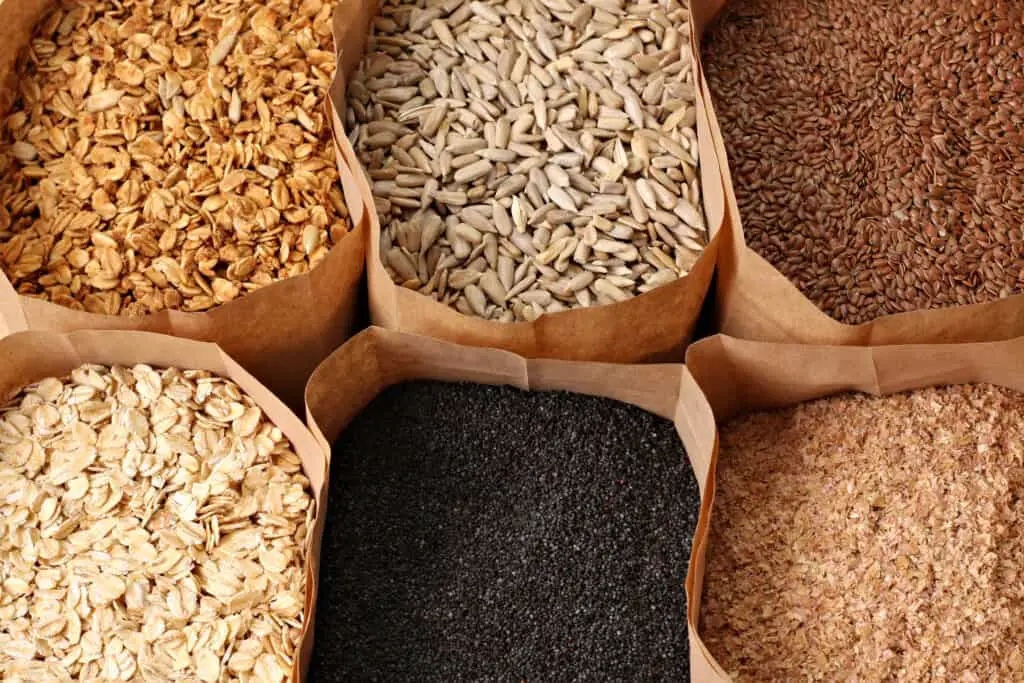
Although most flour is made from wheat, it can also be made from other starchy plant foods. These include barley, buckwheat, corn, lima beans, oats, peanuts, potatoes, soybeans, rice, and rye. Many varieties of wheat exist for use in making flour. In general, wheat is either hard (containing 11-18% protein) or soft (containing 8-11% protein).
Flour intended to be used to bake bread is made from hard wheat. The high percentage of protein in hard wheat means the dough will have more gluten, allowing it to rise more than soft wheat flour. Flour intended to be used to bake cakes and pastry is made from soft wheat. All-purpose flour is made from a blend of soft and hard wheat.
Durum wheat is a special variety of hard wheat, which is used to make a kind of flour called semolina. Semolina is most often used to make pasta.
Flour usually contains a small amount of additives. Bleaching agents such as benzoyl peroxide are added to make the flour more white. Oxidizing agents (also known as improvers) such as potassium bromate, chlorine dioxide, and azodicarbonamide are added to enhance the baking quality of the flour.
These agents are added in a few parts per million. Self-rising flour contains salt and a leavening agent such as calcium phosphate. It is used to make baked goods without the need to add yeast or baking powder. Most states require flour to contain added vitamins and minerals to replace those lost during milling. The most important of these are iron and the B vitamins, especially thiamin, riboflavin, and niacin.
The Manufacturing Process
Grading the wheat
Wheat is received at the flour mill and inspected. Samples of wheat are taken for physical and chemical analysis. The wheat is graded based on several factors, the most important of which is the protein content. The wheat is stored in silos with wheat of the same grade until needed for milling.
Purifying the wheat
In 1795, an American engineer published a book called The Young Millwright and Miller’s Guide. In the book, simple theories are transformed into a set of mechanical devices that form a flour mill. At the back of the book is a drawing, illustrating how these devices make a continuous production line in which the human hand is eliminated from the beginning of the process to the end of production.
The author of this book was Oliver Evans, himself the son of a miller. He and his brothers ran their own mill, developed the systems, and perfected the operations that led to the automated grain mill.
Today, Evans is considered one of America’s most ambitious mechanical innovators. He used his understanding of the way in which water turned a mill wheel and developed it into a viable grain-milling system.
Most important was the fact that his system contained the idea of the integrated and automated factory. When a machine substitutes human intervention, the problems of the fully automated assembly line are solved. This concept was not fully applied until the 1920s by Henry Ford, who was able to develop a successful, operational assembly line.
Ford had the advantage of living at the end of the machine age, but Oliver Evans was the first to present the concept of automation before it was even possible.
The Purification Process Explained
Before wheat can be ground into flour it must be free of foreign matter. This requires several different cleaning processes. At each step of purification the wheat is inspected and purified again if necessary.
The first device used to purify wheat is known as a separator. This machine passes the wheat over a series of metal screens. The wheat and other small particles pass through the screen while large objects such as sticks and rocks are removed.
The wheat next passes through an aspirator. This device works like a vacuum cleaner. The aspirator sucks up foreign matter which is lighter than the wheat and removes it.
Other foreign objects are removed in various ways. One device, known as a disk separator, moves the wheat over a series of disks with indentations that collect objects the size of a grain of wheat. Smaller or larger objects pass over the disks and are removed.
Another device, known as a spiral seed separator, makes use of the fact that wheat grains are oval while most other plant seeds are round. The wheat moves down a rapidly spinning cylinder. The oval wheat grains tend to move toward the center of the cylinder while the round seeds tend to move to the sides of the cylinder, where they are removed.
Other methods used to purify wheat include magnets to remove small pieces of metal, scourers to scrape off dirt and hair, and electronic color sorting machines to remove material which is not the same color as wheat.
Preparing the wheat for grinding
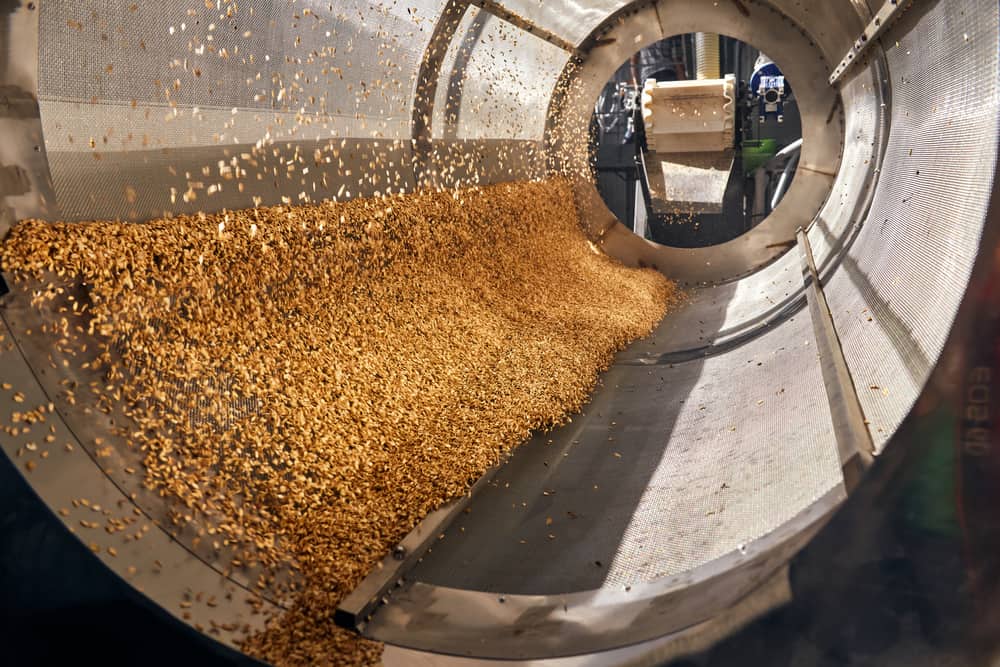
The purified wheat is washed in warm water and placed in a centrifuge to be spun dry. During this process any remaining foreign matter is washed away. The moisture content of the wheat must now be controlled to allow the outer layer of bran to be removed efficiently during grinding. This process is known as conditioning or tempering. Several methods exist of controlling the amount of water present within each grain of wheat.
Usually this involves adding, rather than removing, moisture.Cold conditioning involves soaking the wheat in cold water for one to three days. Warm conditioning involves soaking the wheat in water at a temperature of 115°F (46°C) for 60-90 minutes and letting it rest for one day. Hot conditioning involves soaking the wheat in water at a temperature of 140°F (60°C) for a short period of time.
This method is difficult to control and is rarely used. Instead of water, wheat may also be conditioned with steam at various temperatures and pressures for various amounts of time. If conditioning results in too much moisture, or if the wheat happens to be too moist after purification, water can be removed by vacuum dryers.
Grinding the wheat
Wheat of different grades and moistures is blended together to obtain a batch of wheat with the characteristics necessary to make the kind of flour being manufactured. At this point, the wheat may be processed in an Entoleter, a trade name for a device with rapidly spinning disks which hurl the grains of wheat against small metal pins. Those grains which crack are considered to be unsuitable for grinding and are removed.
The wheat moves between two large metal rollers known as breaker rolls. These rollers are of two different sizes and move at different speeds. They also contain spiral grooves which crack open the grains of wheat and begin to separate the interior of the wheat from the outer layer of bran. The product of the breaker rolls passes through metal sieves to separate it into three categories.
The finest material resembles coarse flour and is known as middlings or farina. Larger pieces of the interior are known as semolina. The third category consists of pieces of the interior which are still attached to the bran. The middlings move to the middlings purifier and the other materials move to another pair of breaker rolls. About four or five pairs of breaker rolls are needed to produce the necessary amount of middlings.
The middlings purifier moves the middlings over a vibrating screen. Air is blown up through the screen to remove the lighter pieces of bran which are mixed with the middlings. The middlings pass through the screen to be more finely ground.
Middlings are ground into flour by pairs of large, smooth metal rollers. Each time the flour is ground it passes through sieves to separate it into flours of different fineness. These sieves are made of metal wire when the flour is coarse, but are made of nylon or silk when the flour is fine. By sifting, separating, and regrinding the flour, several different grades of flour are produced at the same time. These are combined as needed to produce the desired final products.
Processing the flour
Small amounts of bleaching agents and oxidizing agents are usually added to the flour after milling. Vitamins and minerals are added as required by law to produce enriched flour. Leavening agents and salt are added to produce self-rising flour. The flour is matured for one or two months.
The flour is packed into cloth bags which hold 2, 5, 10, 25, 50, or 100 lb (About 0.9, 2.3, 4.5, 11.3, 22.7, or 45.4 kg). For large-scale consumers, it may be packed in metal tote bins which hold 3000 lb (1361 kg), truck bins which hold 45,000 lb (20,412 kg), or railroad bins which hold 100,000 lb (45,360 kg).
Quality Control
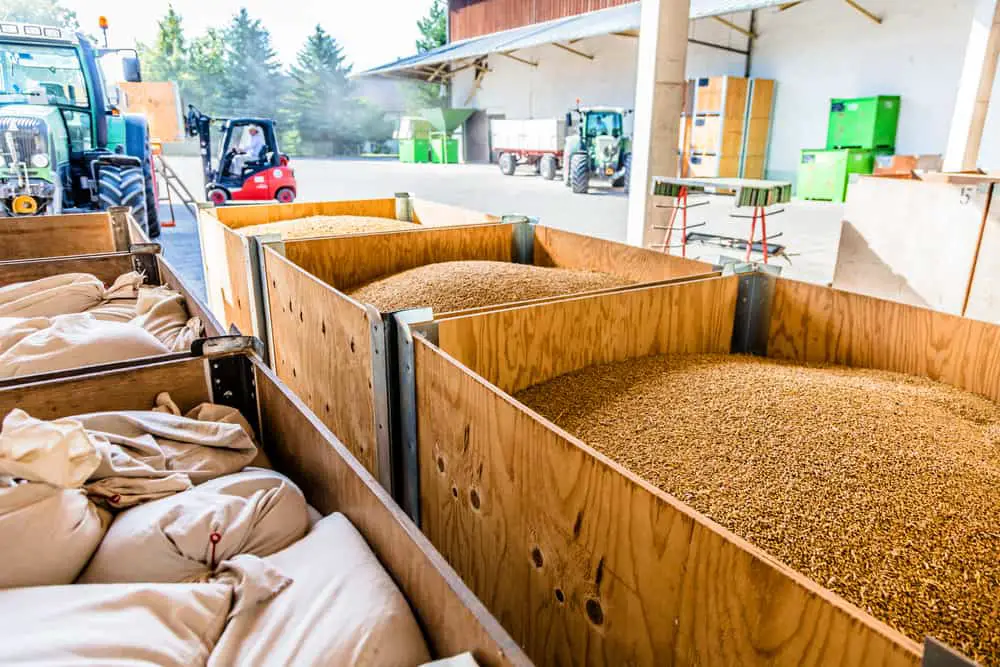
The quality control of flour begins when the wheat is received at the flour mill. The wheat is tested for its protein content and for its ash content. The ash content is the portion which remains after burning and consists of various minerals.
During each step of the purification process, several samples are taken to ensure that no foreign matter ends up in the flour. Since flour is intended for human consumption, all the equipment used in milling is thoroughly cleaned and sterilized by hot steam and ultraviolet light. The equipment is also treated with antibacterial agents and antifungal agents to kill any microscopic organisms which might contaminate it.
Hot water is used to remove any remaining traces of these agents.
The final product of milling is tested for baking in test kitchens to ensure that it is suitable for the uses for which it is intended. The vitamin and mineral content is measured in order to comply with government standards. The exact amount of additives present is measured to ensure accurate labeling.
Byproducts and Waste
A kernel of wheat consists of three parts, two of which can be considered byproducts of the milling process. The bran is the outer covering of the kernel and is high in fiber. The germ is the innermost portion of the kernel and is high in fat. The endosperm makes up the bulk of the kernel and is high in proteins and carbohydrates. Whole wheat flour uses all parts of the kernel, but white flour uses only the endosperm.
Bran removed during milling is often added to breakfast cereals and baked goods as a source of fiber. It is also widely used in animal feeds. Wheat germ removed during milling is often used as a food supplement or as a source of edible vegetable oil. Like bran, it is also used in animal feeds.
How Is Flour Made Today?
Modern mills typically use electricity or fossil fuels to spin heavy steel, or cast iron, serrated and flat rollers to separate the bran and germ from the endosperm. The endosperm is ground to create white flour, which may be recombined with the bran and germ to create whole grain or graham flour. The different milling techniques produce visibly different results, but can be made to produce nutritionally and functionally equivalent output.
Stone-ground flour is preferred by many bakers and natural food advocates because of its texture, nutty flavor, and the belief that it is nutritionally superior and has a better baking quality than steel-roller-milled flour. It is claimed that, as the stones grind relatively slowly, the wheat germ is not exposed to the sort of excessive temperatures that could cause the fat from the germ portion to oxidize and become rancid, which would destroy some of the vitamin content.
Stone-milled flour has been found to be relatively high in thiamin, compared to roller-milled flour, especially when milled from hard wheat.Gristmills only grind “clean” grains from which stalks and chaff have previously been removed, but historically some mills also housed equipment for threshing, sorting, and cleaning prior to grinding.
Modern mills are usually “merchant mills” that are either privately owned and accept money or trade for milling grains or are owned by corporations that buy unmilled grain and then own the flour produced.
Take a look at this video to see the process broken down:
How Is Flour Produced?
The actual production process that creates the flour can be hard to understand at first, mostly because the finished product is a completely different substance than how it started. In modern milling of refined flours the wheat kernels are cleaned and tempered by the addition or removal of moisture and then split open by a pair of rolls. The finest particles, called break flour, are sieved out and bagged.
Coarser particles of endosperm (called semolina) and pieces of bran with endosperm attached are then subjected to a series of rolls in which semolina of steadily reducing size is gradually ground to flour and the bran separated out. The flour is usually bleached and treated to obtain the improved bread-making qualities formerly achieved by natural aging. Flour grades are based on the residual amount of branny particles.
When flour is mixed with water to make dough, its protein content is converted to gluten, an elastic substance that forms a continuous network throughout the dough and is capable of retaining gas, thus causing the baked product to expand, or rise. The strength of the gluten depends upon the protein content of the flour.
Soft wheats, containing approximately 8–12 percent protein, produce flours that are suitable for products requiring minimal structure, such as cakes, cookies (sweet biscuits), pie crusts, and crackers. Hard wheats, which are high in protein (approximately 12–15 percent), produce flours that are suitable for products requiring stronger structure, such as breads, buns, hard rolls, and yeast-raised sweet rolls.
The wide variety of wheat flours generally available includes whole wheat, or graham, flour, made from the entire wheat kernel and often unbleached; gluten flour, a starch-free, high-protein, whole wheat flour; all-purpose flour, refined (separated from bran and germ), bleached or unbleached, and suitable for any recipe not requiring a special flour.
Cake flour, refined and bleached, with very fine texture; self-rising flour, refined and bleached, with added leavening and salt; and enriched flour, refined and bleached, with added nutrients.
Flours are also made from other starchy plant materials including barley,
How Is Almond Flour Made?
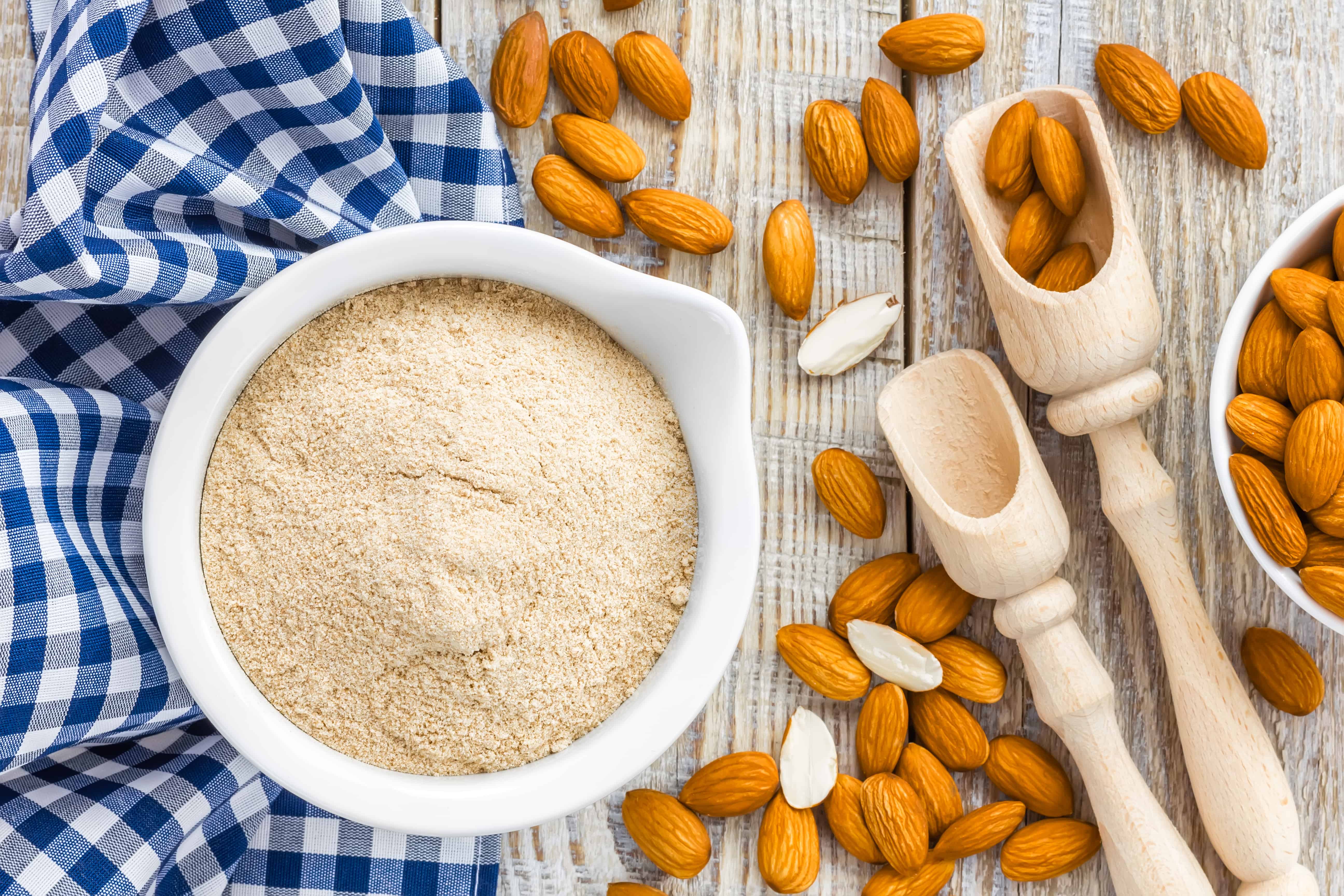
Almond flour is made from ground almonds.
The process involves blanching almonds in boiling water to remove the skins, then grinding and sifting them into a fine flour.
Almond flour is not the same as almond meal, despite the fact that their names are sometimes used interchangeably.
Almond meal is made by grinding almonds with their skins intact, resulting in a coarser flour.
This difference is important in recipes where texture makes a big difference.
Making your own almond flour at home is as simple as adding blanched almonds to your food processor or blender, and processing them until they are finely ground. However, there are a few tips and best practices to keep in mind:
- One cup of slivered almonds = about one cup of almond flour.
- One 8 oz. a bag of these raw blanched slivered almonds turned into exactly 2 cups of almond flour–> just what you need for my almond flour cookie recipe!
- Only process one cup of almonds at a time. Blending more than that creates an uneven texture, so you’ll wind up with clumps of un-ground almonds.
- If you don’t mind seeing specks of brown in your resulting baked goods, you can also use regular whole almonds (non-blanched) to make almond meal. Almond meal makes “cakier” baked goods, rather than giving baked goods a buttery, shortbread-texture the way almond flour does.
Useful Tip: a food processor can definitely be used if that’s all you have. The resulting baked goods will just be slightly grainier that way.
How Is White Flour Made?
White flour is made from the endosperm only. Old stone mills used to grind flour slowly, but today’s methods are mass produced and much faster. Even most of your whole wheat flour has lost a lot of nutrients due to this type of processing. They start by peeling off the husk and bran and crushing the grain.
The husk and bran are the most nutritious parts. Refining food destroys nutrients. What’s remaining are pure carbohydrates or a form of sugar. Bleached flour, as you may have guessed, is whiter than the unbleached flour. But how did it get that way? Well when flour is chemically bleached, it is similar to bleaching your clothes in the laundry. Flour bleaching agents are a food additive added to flour in order to make it appear whiter.
How Is Rice Flour Made?
Rice flour is made from finely milled rice. It is different from rice starch, which is usually produced by steeping rice in lye. Rice flour is a particularly good substitute for wheat flour, which some people believe irritates their digestive system. It is also used as a thickening agent in recipes that are refrigerated or frozen since it inhibits liquid separation.
Rice flour may be made from either long-grain to medium-grain white rice or brown rice. To make the flour, the husk of rice or paddy is removed and raw rice is obtained, which is then ground to flour. For brown rice flour, the bran is not removed but for white rice it is.
But what’s the difference between white and brown rice flour? Rice flour has a slight chewy texture. For baking, both white and brown rice flour are interchangeable. Brown rice has a more nutty flavor and a shorter lifespan compared to its white counterpart. Generally, brown rice flour has a healthier kick to it but do note that both are gluten-free.
Compared to the white rice flour, brown rice flour has a denser taste but you can always balance this out with lighter flours such as almond flour. Aside from usage in baking, white rice flour is a staple ingredient in most cuisines such as in rice noodles, pancakes, and Korean rice cakes.
What’s the difference between rice flour and glutinous rice flour?
Although both are made from rice, glutinous rice flour is ground from long-grain or short-grain sweet or sticky white rice. Both flour types are neutral in taste before and after cooking. In comparison to rice flour, glutinous rice has a more sticky and chewy texture like mochi.
If you’re looking to substitute rice flour with glutinous rice flour and vice versa, this might not be the best option because of the difference in texture.
Rice flour is more versatile due to its light texture and feel making them perfect for light batters and gluten-free baking. On the other hand, glutinous rice flour is better used as a thickening agent in soups for its chewy texture after cooking.
How Is Coconut Flour Made?

Coconut flour is a soft, flour-like product made from the pulp of a coconut. It’s actually a byproduct made during the coconut milk making process. When making coconut milk, you have to soak coconut meat. That pulp is then dried out and ground into this powdery flour.
What are the health benefits of coconut flour?
Many people look to coconut flour to help create gluten free baked goods. Gluten free is definitely a great reason to use coconut flour, but that’s not all it has to offer. Coconut flour is also extremely high in fiber with almost double the amount found in wheat bran.
How Is Gluten-Free Flour Made?
Gluten is a protein found in wheat, rye, barley and triticale (a cross between wheat and rye), which – when water or liquid is added to it – makes an elastic dough. Gluten-free flours on their own do not have this elasticity and typically produce a much denser product.
Commercially available gluten-free flours are all made with different mixtures and these mixtures vary widely from brand to brand. They might contain rice flour, teff flour, tapioca flour, sorghum flour, potato starch, garbanzo flour or buckwheat flour. These flours could also contain nut meals, made from very finely ground almonds or other nuts.
Gluten-free foods are typically grown, transported, stored, processed, and packaged in gluten-free environments.
Xanthan gum is a binder that is frequently added to gluten-free flour mixes to give the flour some elasticity and make it easy to use right out of the bag. Since the base ingredients for gluten-free flour can vary, different brands can produce very different results in baked goods, giving a recipe a completely new taste and texture.
How Is Chickpea Flour Made?
Chickpea flour adds a nutty taste and a boost of protein, and it works well in any dish, from baked goods to soups and sauces. Chickpea flour also makes a good alternative if you’re following a wheat-free or gluten-free diet. Chickpea flour is nothing more than dried chickpeas, ground to a flour-like consistency. Other names for chickpea flour include gram flour, cici flour and garbanzo bean flour.
Besan (more below) is chickpea flour made with unroasted chickpeas. Chana is flour made from roasted chickpeas. Even though it’s naturally gluten-free, flour is easily cross-contaminated if it’s produced or used in close proximity to wheat flour. All you need to make your own chickpea flour is a blender or food processor and dried chickpeas, which you can find with dried beans and peas at any supermarket.
Rinse the chickpeas with clear water, then either let them dry overnight or spread them on a cookie sheet and toast them for 15 to 20 minutes in a hot oven. Process the dried chickpeas in a blender or food processor in small batches until they are the consistency of flour. Store the chickpea flour in a closed container in your refrigerator or freezer. A 1-pound package of dried chickpeas makes about 2 cups of chickpea flour.
How Is Bread Flour Made?
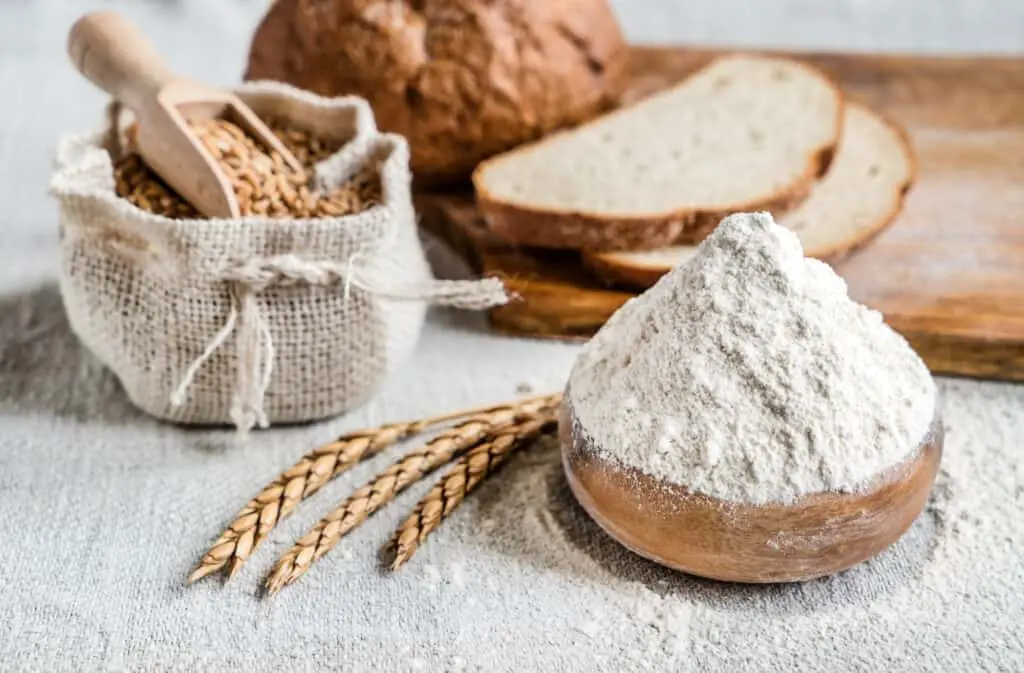
Bread flour is a high-protein patent flour specifically milled for yeasted breads. Unlike whole wheat flour which is milled from the whole wheat kernel, bread flour is made from just the protein-rich endosperm of hard red spring or hard red winter varieties.
The protein component, mainly gluten, is an essential constituent of raised wheat bread allowing its expansion after leavening.
Several types of bread flour are commercially available, namely, all-purpose flour, enriched flour, gluten flour and self-rising flour. Bread flour is available bleached or unbleached and may contain added malted barley flour and nutrients. It’s is typically used for:
- Pan bread
- Rolls
- Croissants
- Sweet yeast doughs
Origin of bread flour
African-American inventor Joseph Lee patented bread flour in 1902 in Boston. Even earlier than this, however, Hovis flour was created in the UK in 1886, when miller Richard Smith discovered a way to separate wheat germ from the flour, cooking it and adding it back into the flour while preventing fermentation which would spoil the flour. Gold Medal introduced what was called “High Protein Flour” in the 1920s.
Function
Bread flour allows greater water absorption and longer mixing time for dough development. It has the following functions:
- Structure
- Texture
- Flavor
Bread flour is best used where strong gluten development and yeast-generated flavors are needed. The higher protein content of bread flour (11.5 to 13.5%) is responsible for the characteristic attributes such as texture, appearance, and hard crust.
There are many different types of bread flours on the market, all varying in protein level, as well as blend. Some may have a 50-50 blend of hard winter and spring wheat, with spring wheat being typically more expensive but better in protein quality. Some even have hard white wheat blended into the mix. The flour can be bleached or unbleached depending on the desired characteristics of the final product. Most flour brands have bread flour available.
Bread flour is produced for commercial bakeries at a flour mill, mostly from hard red wheat. The flour is milled according to customer specifications to ensure the desired amount of proteins and particle size. Gluten proteins reside in the endosperm. Flour ash content is used as an index of flour refinement, with low ash indicating highly refined flours.
How Is Corn Flour Made?
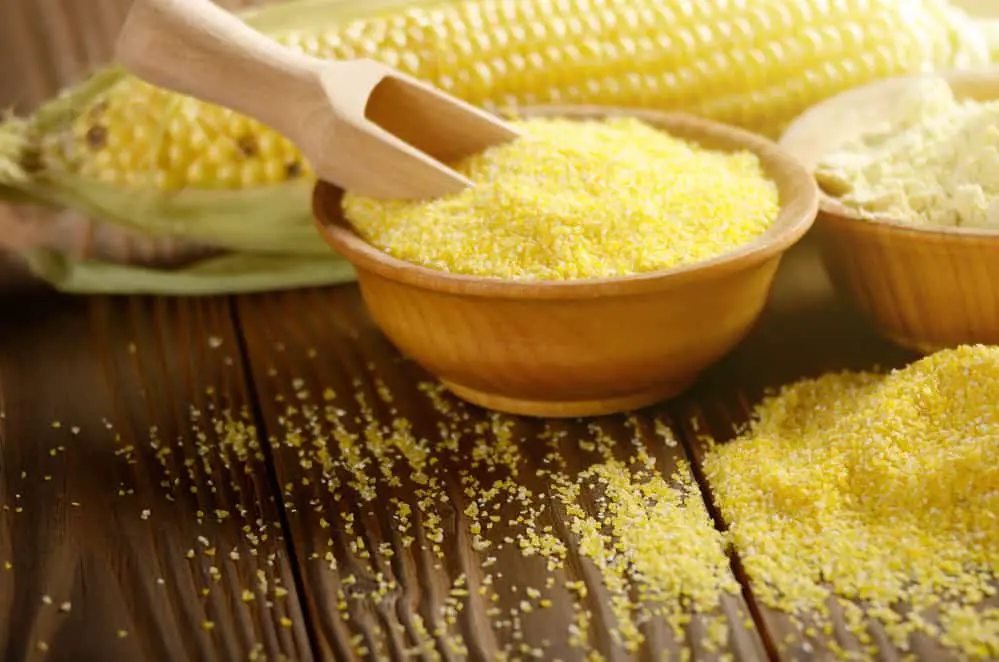
Corn flour is a type of flour that’s milled from dried whole corn kernels. It contains the hull, germ, and endosperm of the corn and is considered a whole grain flour. Corn flour is usually yellow, but it can also be white or blue depending on the variety of corn it uses. The texture is fine and smooth, similar to whole wheat flour. Like all flours, corn flour gives structure to baked goods and other foods.
It’s often combined with a binder like eggs to provide shape. Corn flour doesn’t taste very good raw, but cooking—whether it’s baking, frying, or grilling—unlocks its earthy, sweet flavor. Corn flour is extremely versatile, and you can incorporate it into recipes for breads, muffins, waffles, pancakes, battered and fried foods, blinis, and more.
Making corn flour at home sounds intimidating, but it’s much easier than you’d expect. The only ingredient you need is corn, but it must be dried beforehand. Traditional methods involve drying corn under the sun, removing it from the cob, then passing it through a grain mill, but there’s a much simpler way to do this. All you need are popcorn kernels and a high-powered blender like Vitamix or Blendtec.
The type of blender you use is important, as the blades need to be powerful enough to grind the kernels. Your standard blender container and blades should work fine—but you may want to consider buying a dry-grains container that’s specifically designed for grinding whole grains.
Simply add the kernels to the blender container until filled about halfway. Blend kernels on HIGH until a fine powder forms. Place in an airtight container or plastic zip-top bag, refrigerate, and use within several days. You can also place the flour in a plastic zip-top freezer bag and store in the freezer for up to six months.
How Is Oat Flour Made?
Oat flour is finely ground from whole oat groats. Groats are the kernels that have been removed from the inedible hull of the oat grain.
Because the process begins with the whole grain, oat flour contains all the available fiber, protein, vitamins and minerals. The overall benefits of oats have been proven by a number of scientific resources, and therefore oat flour can be a vital part of a healthy diet.
Oat flour is full of flavor and contains a balanced array of wholesome nutrition. Although it’s not the only naturally gluten-free ingredient, oat flour has found its way into many wheat-free recipes. If you have a grain mill, start with oat groats or steel-cut oats and run them through the grain mill.
- Load your oats into the hopper or container for your grain mill.
- Adjust the setting of grinding to fine.
- Turn on or crank to process the oats.
- Place your homemade oatmeal flour into an airtight container or bag and remove any extra air.
- Seal and store on your pantry shelf for up to 3 months.
How Is Whole Wheat Flour Made?
In America, traditional whole wheat flours are ground from the entire wheat berry (the bran, germ and endosperm) of hard red spring wheat.
Whole wheat flour contains all the nutrients of the whole wheat berry and gives a darker color and nutty flavor to breads and baked goods. (Whole wheat flour is sometimes referred to as graham flour).
All the extra fiber in whole wheat flour does pose one problem for baking. Fiber inhibits gluten (protein) development, which you need for a good rise in your baked goods. This means that whole wheat flour breads won’t rise as high as all-purpose flour breads, resulting in a heavier and denser loaf.
Whole-wheat flour is made from hard red spring or winter wheat, which has a nutty, hearty taste.
All three layers of the wheat berries are ground — the bran, germ, and endosperm — to result in a bold, wholesome flour. If you were to take these wheat varieties, strip them of their nutty-tasting, fiber-rich bran and germ, and grind just the endosperm, you’d get all-purpose flour.
Whole-wheat flour can be used interchangeably for white whole-wheat flour called for in a recipe, or it can be substituted for half the amount of all-purpose flour in a recipe.
How Is Potato Flour Made?
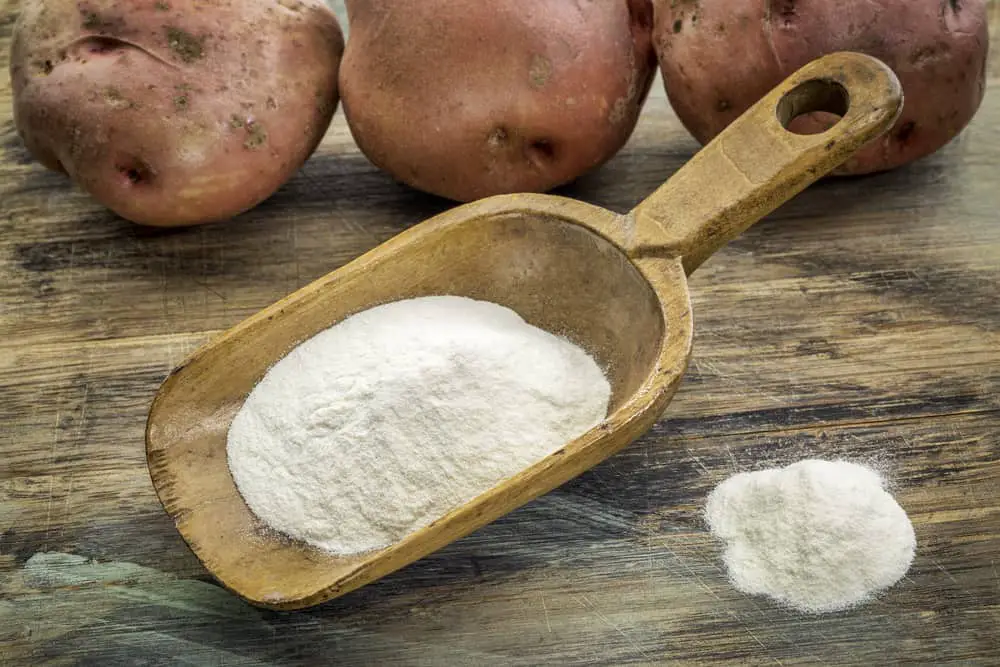
Potato flour is a powder made from ground potatoes that is commonly used in baking. Some cooks use it as a thickener, and it can also add flavor and texture to foods like cakes, breads, and cookies.
It is popular as a gluten-free alternative to regular wheat-based flour, and Jewish cooks sometimes also use it when preparing foods according to Passover dietary restrictions, which prohibit the use of many grains. In most cases, potatoes are the only ingredient in this sort of flour, though some manufacturers add preservatives to keep it fresh and to extend its shelf life.
Whole potatoes are first cooked, usually in large industrial ovens, then dehydrated. From here, manufacturers grind them into a fine powder for an end result that resembles wheat flour in texture and feel, though it usually reacts very differently in recipes.
How Is Cake Flour Made?
Cake flour is a light, finely milled flour with a lower protein content than all-purpose flour. Cake flour is milled from soft wheat and contains the lowest amount of protein when compared to other flours, around 5 to 8%. For comparison’s sake, all purpose flour is usually 10 to 13% protein, which can produce good results for almost any recipe.
However, the low protein and high starch content in cake flour helps create the lightest, most delicious cakes possible. The thing that differentiates all flours from one another is something you’ve probably heard about a few times this year: gluten. Gluten makes up the protein content of flours, and every type of flour has a different protein content. In your baked goods and doughs, the gluten protein content helps the flour bind all the ingredients together.
This means that the higher the protein content in your flour, the more dense and sticky the dough or batter will be. You can imagine that a flour often used in cakes and light-textured products would logically have a low protein content. And you’d be right. As mentioned, cake flour ranges between 5-8% protein, whereas all purpose flour ranges between 10-13% protein.
How Is Whole Grain Flour Made?
Whole-grain flour is defined as having the compositional ingredients of bran, germ, and endosperm in the flour, as is present in the native state. Whole grain flour is prepared by milling the whole buckwheat seed in a similar way to wheat, but the buckwheat achenes must first be dehulled by impact milling or abrasion with emery stones or grinding plates.
This procedure removes 25%–30% of the achene. The groats are roller-milled into various grades of white flour for food processing. The extraction yield is around 55%, mainly depending on variety which is obtained 55.4% for common and 55.6% for tartary buckwheat with this milling technique. The composition of the milling fractions is very different depending on the tissues (endosperm, embryo, and maternal tissues) that comprise the fraction.
How Is Semolina Flour Made?
Semolina is the coarse, purified wheat middlings (intermediate milling stage) of durum wheat mainly used in making couscous, pasta, and sweet puddings. The term semolina is also used to designate coarse middlings from other varieties of wheat, and sometimes other grains (such as rice or corn) as well.
As the wheat is fed into the mill, the rollers flake off the bran and germ while the starch (or endosperm) is cracked into coarse pieces in the process. Through sifting, these endosperm particles, the semolina, are separated from the bran.
The semolina is then ground into flour. This greatly simplifies the process of separating the endosperm from the bran and germ, as well as making it possible to separate the endosperm into different grades because the inner part of the endosperm tends to break down into smaller pieces than the outer part. Different grades of flour can thus be produced.
How Is Cassava Flour Made?
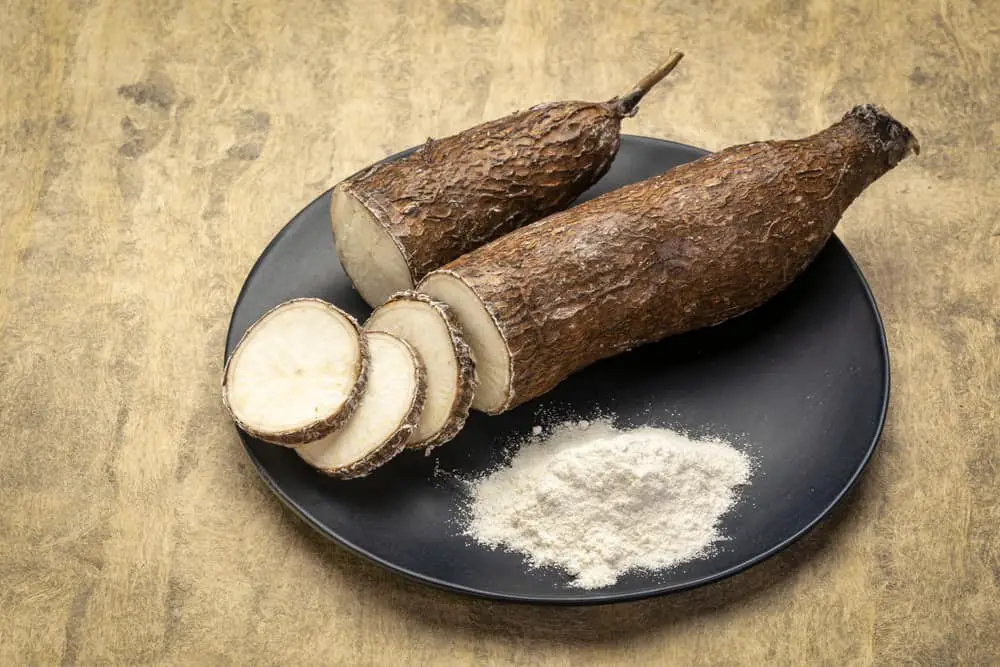
Native to South America, cassava is heavily relied upon as an energy source in Sub-Saharan Africa. Becoming a popular gluten-free flour alternative and thickener, cassava flour (aka tapioca flour) is made from the starchy root of the yucca plant.
It is not refined; the whole root is used to make flour. Use caution if attempting to make your own cassava flour and never eat raw cassava: It contains a compound that produces cyanide, which is eliminated when cooked.
Popular among paleo diet followers, cassava flour can be found in the baking or gluten-free sections of the grocery store. Compared to whole-wheat flour, cassava flour is more expensive at about $9 to $10 per pound. Cassava flour can be substituted 1:1 in recipes calling for wheat flour.
How Is Bleached Flour Made?
Historically, flour whitening was done ‘naturally’ by allowing the freshly-milled wheat to sit for 1-2 months and get exposed to oxygen. That process became impractical due to required investment in time, space and contamination prevention.
Flour bleaching with additives was introduced following a 1906 Congressional Landmark Pure Food and Drug Act which addressed the safety of chemical additives. Nitrous oxide was one of the first additives adopted by American mills as a flour whitener. Other flour bleaching agents were soon added to the approved food additives list including chlorine gas in 1912 and benzoyl peroxide powder a few years later in 1921.
Process
Flour bleaching agents are added directly to the freshly-milled flour. Powder bleaching agents such as benzoyl peroxide are mixed directly with the flour. Whitening is often completed in two days. Gaseous bleaching agents such as nitrogen peroxide and chlorine are fed into a bin containing the freshly-milled flour. Bleached flour is more economical than the unbleached version due to its ease of production.
How Is Enriched Flour Made?
Flour enrichment is the addition of nutrients to white flour that are removed during milling. When wheat is milled, bran and germ from the wheat kernel are removed and the endosperm is processed into white flour, stripping all dietary fiber, minerals, and vitamins. Flour enrichment adds back the naturally occurring ones.
Flour enrichment calls for the addition of the following:
- Niacin
- Thiamin
- Riboflavin
- Folic acid
- Iron
Flour enrichment began due to the increase in the diseases caused by vitamin and mineral deficiencies. The nutritional needs of North Americans are re-evaluated periodically and flour enrichment is adapted.
Origin
Flour enrichment can provide an important source of iron in the diet. In the U.S., flour enrichment was established in the 1930’s as the popularity of white flour increased. Health concerns about the rise in cases of diseases such as beriberi and pellagra led to an examination of white flour. Both beriberi and pellagra are caused by vitamin and mineral deficiencies.
The addition of B vitamins and iron to white flour eliminated the diseases beriberi and pellagra.
The initial enrichment of white flour called for niacin, thiamin, riboflavin and iron. In the 1990’s folic acid was added in order to prevent the risk of coronary heart disease and birth defects such as spina bifida.
The use of enriched flour is less common in countries where wholemeal flour is preferred.
Function
Flour enrichment provides added minerals and vitamins to refined white flour.
Flour enrichment provides the following:
- Thiamin aids digestion and helps the body process fat and carbohydrates.
- Riboflavin is an essential vitamin that aids the body in the use of protein.
- Niacin is responsible for preventing pellagra.
- Pellagra is a nutrients deficiency disease that can lead to death if untreated. Iron is essential to prevent anemia.
- Iron carries oxygen from the lungs to other parts of the body.
Commercial Production
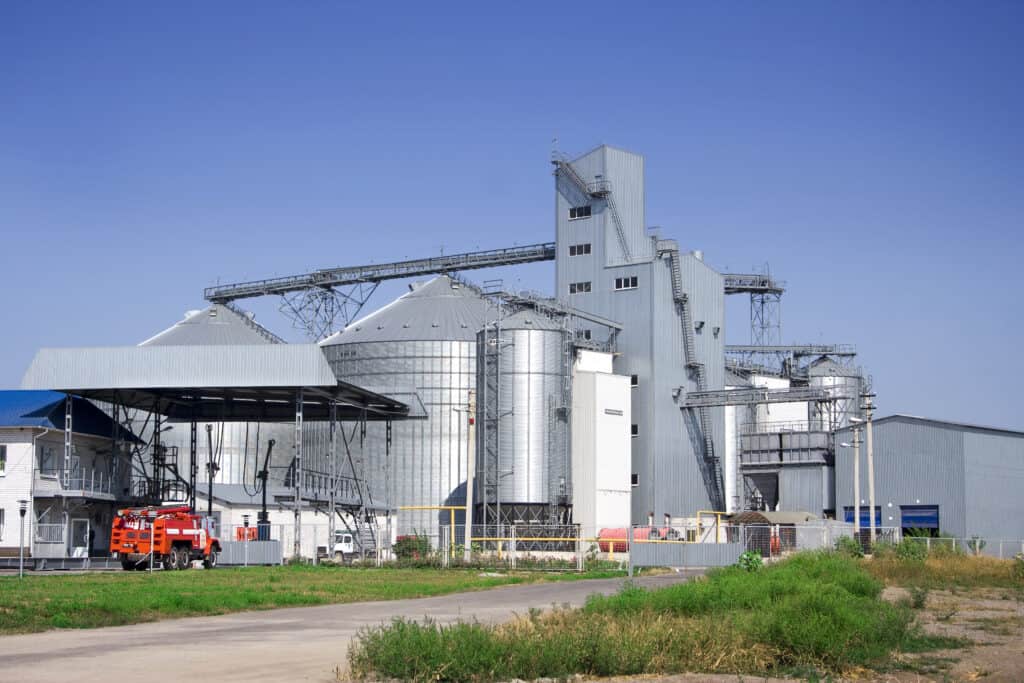
Wheat goes through the milling process to become flour. White flour that is produced from the grounded endosperm of the wheat kernel has had all vitamins and minerals stripped. After processing white flour is run through a device that measures out specified quantities of enrichment. If the flour is self-rising, a leavening agent, salt and calcium are also added in exact amounts.
How Is Tapioca Flour Made?
Tapioca flour is an alternative to traditional wheat flours and starches. It is a popular ingredient for recipes that do not contain gluten, particularly helping to improve the structure and texture of baked goods. Here are all the things you need to know about this essential baking ingredient!
Tapioca Flour is derived from the starchy vegetable called cassava root. The root is finely shredded, washed and dehydrated. The dried pulp is then ground into a flour. Most organic Tapioca Flours are free from GMOs, additives, chemicals and synthetics.
How Is Rye Flour Made?
Rye flour is produced by the milling of rye grain. Various types of flour are produced through various degrees of purification (removal of outer bran coating) and degree of grinding.
Perhaps the most famous product made with rye flour is pumpernickel bread, a yeast-leavened bread made with the darkest rye flour.
Variations of rye flours include:
- Light (patent flour)
- Medium (straight grade)
- Dark (clear flour)
Origin
Rye (Secale cereale), a member of the grass family (Gramineae), is closely related to wheat which has been cultivated since the Neolithic period. It is grown as a winter crop under harsh conditions and accounts for less than 1% of global cereal production.
About 65% of the rye is harvested in eastern Europe (Russia, Poland, and Germany) due to its adaptation to harsh winters and poor soils. In these regions, rye flour is usually mixed with wheat flour for the production of traditional breads.
Function
In baking, rye flour has been traditionally used in the production of flat breads and yeast-leavened breads. Such breads can vary in crumb color from practically white to dark-brown, in shape from round to elongated, and in taste from a mildly sour to a strong distinctive acidic.
This flour is preferred for the production of sourdough starters and artisan breads, especially in Germany, Poland, Ukraine, and other European countries. The grain is also used to produce alcoholic beverages.
Commercial Production of Rye
The rye kernel is more pointed and longer than wheat and barley. Like other cereals, it is composed of starchy endosperm (86.5%), bran (10%), and the germ (3.5%).
Milling rye flour follows the same process principles as those of wheat. Rye and triticale usually have a softer endosperm compared to hard or durum wheat and therefore are tempered to lower moisture contents.
How Is Peanut Flour Made?
If you’re not allergic, peanuts are one of the greatest foods. They offer an almost unparalleled variety of uses, from peanut sesame noodles to chocolate peanut butter waffles to a good old-fashioned PB & J.
Peanut Flour is made through a process of grinding roasted peanuts into a paste and then pressing them to extract the oil. It is often marketed as “defatted” or “partially defatted” and is sold in a plastic jar or bag.
How Is Atta Flour Made?

Atta or Chakki Atta is a finely ground whole wheat flour, produced in India. It’s used to make flatbreads such as chapati, roti, naan, paratha and puri. It is also widespread in Pakistan.
The main difference between Indian whole wheat Atta flour and the normal whole wheat flour from North America is in the milling process and the type of wheat used.
Atta Flour (Chakki Atta) is stone ground into a very fine powder. This process is called Chakki grinding and both the endosperm and bran are finely milled.
If you sift the whole wheat flour made using the Chakki method of grinding. It will not separate into bran and flour because everything is ground together into a fine flour.
